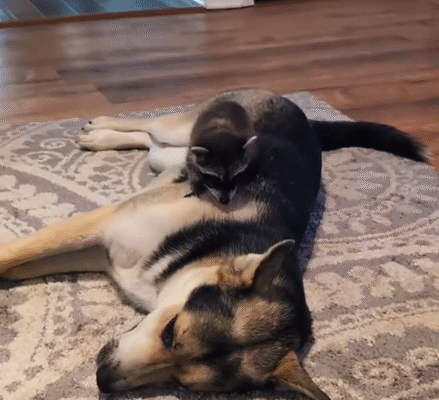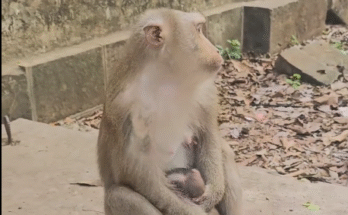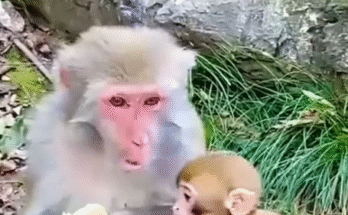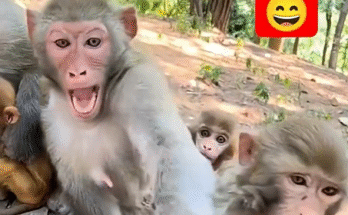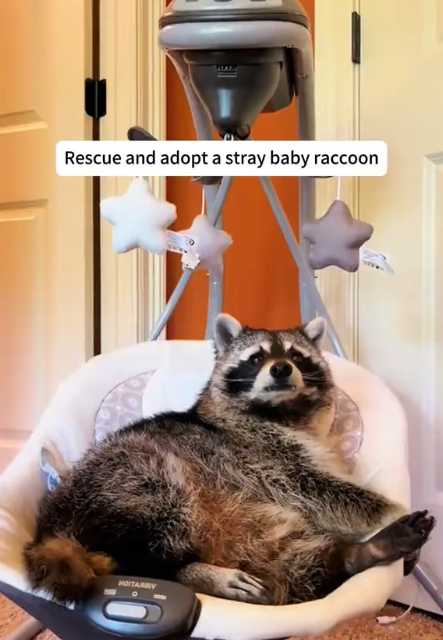
It was a calm spring evening when Emily, a young woman who had recently moved into her countryside cottage, decided to take her usual walk along the wooded trail near her home. With a cup of warm tea in hand and her dog Max trotting beside her, she felt the gentle breeze and listened to the rustle of leaves in the trees. Birds chirped overhead, and the sun began to dip behind the distant hills. Everything felt peaceful—until Max suddenly stopped, his ears perked and nose twitching.
Emily followed Max’s gaze toward a pile of bushes not far from the trail. She heard a faint, high-pitched squeaking noise. Curious and slightly concerned, she stepped closer and carefully pushed the leaves aside. There, huddled and shivering beneath a fallen branch, was a tiny baby raccoon, barely old enough to open its eyes.
The raccoon looked weak, its fur matted and its little belly moving up and down rapidly with shallow breaths. Emily glanced around but saw no sign of a mother raccoon. She waited for a few minutes in silence, hoping the mother might appear, but the forest remained still. As dusk crept in, she realized this baby wouldn’t survive the night alone.
Emily wrapped the baby raccoon gently in her sweater and carried it home. Max, ever curious, sniffed the bundle but remained calm, as though understanding the little creature needed help. At home, Emily placed the raccoon in a cardboard box lined with a towel and began researching online how to care for an orphaned raccoon.
She learned that baby raccoons, also called kits, need warmth, hydration, and very specific food. She warmed a rice sock in the microwave to keep the kit cozy and bought kitten formula from a local store. Using a tiny bottle, she offered it a small amount of formula. The raccoon, weak at first, soon suckled eagerly. Emily smiled. “You’re a fighter,” she whispered, watching it drink.
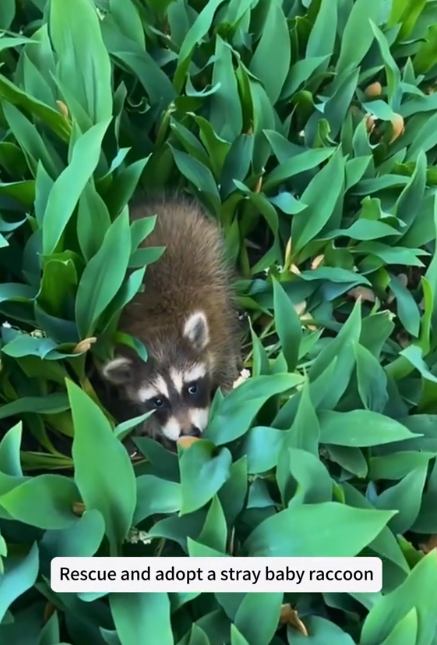
Naming the raccoon “Bandit” for the distinctive black markings around its eyes, Emily committed to taking care of the little one until she could find a wildlife rehab center. But as the days passed, her bond with Bandit deepened. She contacted a wildlife rehabilitation expert who, after hearing how Bandit was progressing, suggested Emily could continue caring for him under their guidance, given her willingness and rural setup.
Raising a baby raccoon wasn’t easy. Emily had to wake up several times a night to feed Bandit in the early weeks. She had to clean up after him, monitor his health, and ensure he was getting the right balance of nutrients. But despite the effort, she found joy in his growth. Bandit started gaining weight, opening his eyes wide to the world, and wobbling around the kitchen floor like a curious toddler.
Raccoons are incredibly intelligent and playful, and Bandit was no exception. By the time he was eight weeks old, he had discovered how to open kitchen cabinets and pull out paper towels to play with. Emily baby-proofed the house as best she could, but Bandit was always one step ahead.
Although raccoons are wild animals and not traditionally kept as pets, Bandit had no mother to teach him survival skills in the wild. Emily followed all the legal steps required in her state, registered Bandit with the local wildlife agency, and created a safe, enclosed outdoor play area for him.
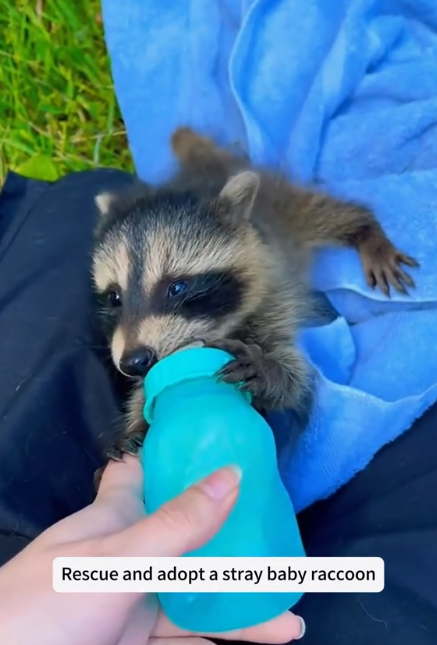
As Bandit grew, Emily introduced him to natural elements—tree branches, logs, leaves, and shallow pools of water where he could learn to forage and wash his food. She knew that his natural instincts were still within him, and she wanted to encourage those behaviors even in a semi-domesticated life.
One of the most heartwarming moments came when Bandit, now a few months old, climbed up Emily’s shoulder, wrapped his tiny arms around her neck, and gave what could only be described as a hug. It was his way of saying thank you. Emily’s heart melted. Despite all the challenges—chewed wires, ruined curtains, and countless sleepless nights—she had no regrets.
Neighbors who once raised their eyebrows at the idea of living with a raccoon soon found themselves charmed by Bandit. Children from the nearby school came to visit and learn about wildlife and compassion. Emily used Bandit’s story to teach others about the importance of helping animals in need and the responsibilities that come with such decisions.
But Emily also knew that not every raccoon should be raised at home. She strongly advised others to consult professionals before taking in a wild animal. Bandit’s situation was unique—he was rescued early, had no chance of survival in the wild, and had been raised under expert guidance. It wasn’t a decision she had taken lightly, and it was a long-term commitment.
Over the next year, Bandit became a beloved part of Emily’s life. He would ride in a special carrier on her bike, go for supervised walks in the woods, and even help her in the garden by digging (though not always in the right spots). Max and Bandit formed a surprising friendship, often napping side by side on the porch or playing chase around the house.
Eventually, Bandit became an ambassador for orphaned wildlife in the community. Emily worked with local vets and wildlife centers to spread awareness about how to handle wildlife encounters. She started a small blog detailing Bandit’s journey—from a shivering, abandoned baby to a healthy, mischievous companion.
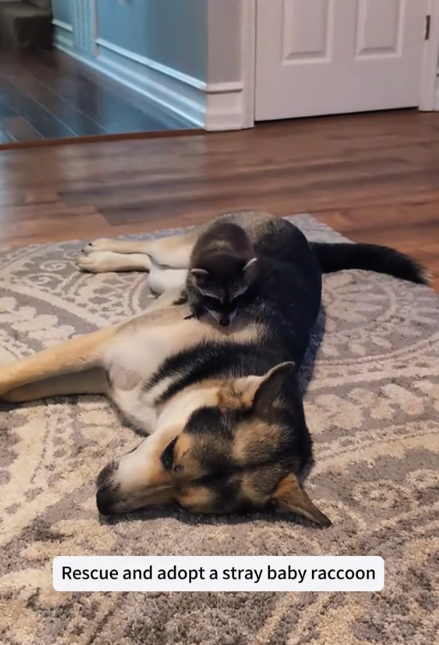
Every year, on the anniversary of Bandit’s rescue, Emily hosted a small “Wildlife Day” event at her home. Children and adults alike came to hear Bandit’s story, donate to animal shelters, and learn how they could make a difference. Bandit, ever the star, would perform his usual antics—opening jars, playing with toys, and occasionally stealing someone’s sunglasses.
The story of rescuing and adopting a stray baby raccoon became a tale of hope, compassion, and coexistence. Emily’s life had changed dramatically since that spring evening, but she wouldn’t have it any other way.
Looking back, she often thought how easily she could have ignored that faint squeak in the woods. But one small act of kindness had grown into a bond that enriched her life in ways she had never imagined.
Bandit wasn’t just a rescued raccoon. He was family.
